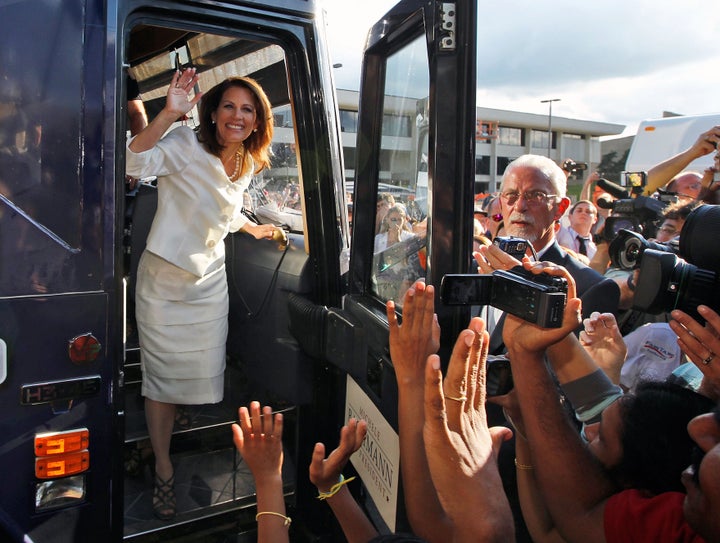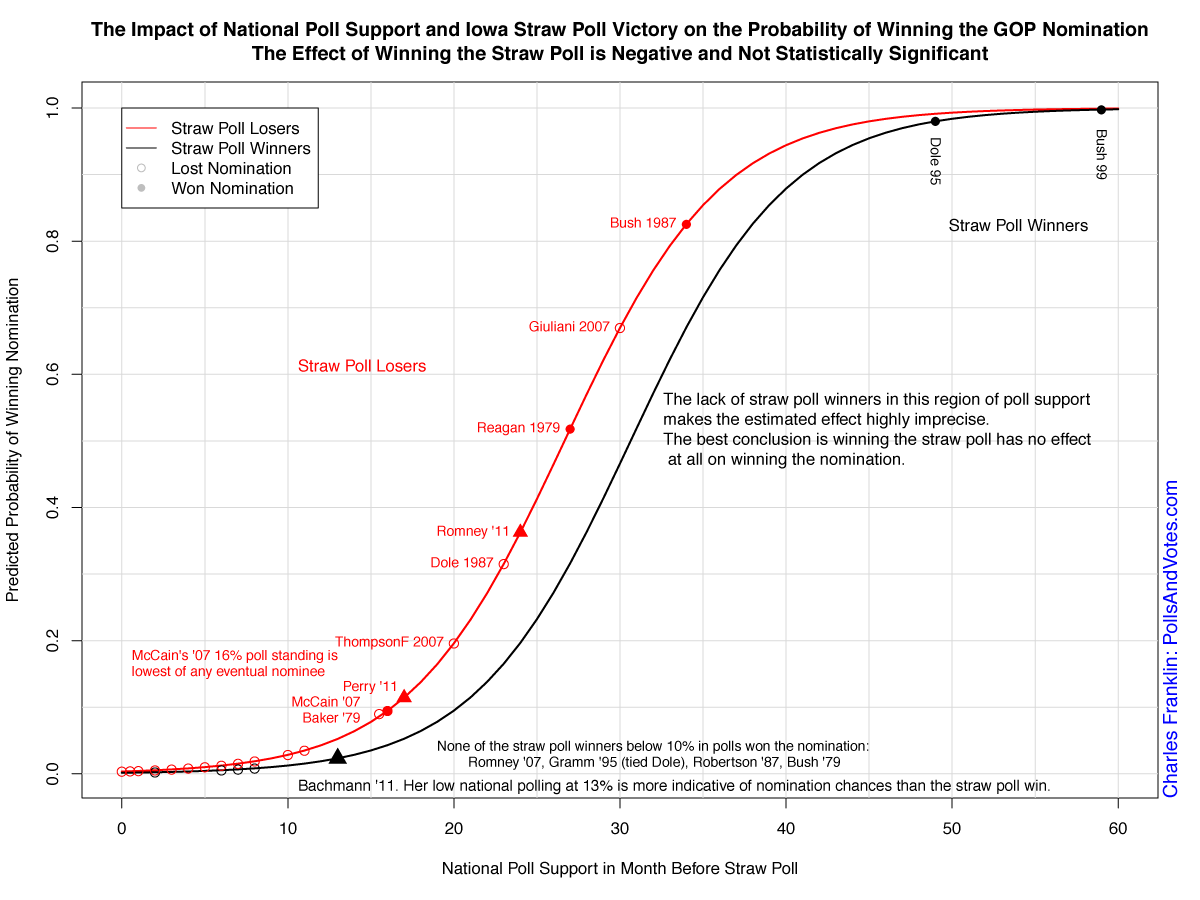

After yesterday's excitement over the Ames straw poll, let's take a look at the history and consequences. With Tim Pawlenty's withdrawal today, it seems Ames does indeed matter, at least for negative consequences, and Michele Bachmann's appearances on Sunday morning shows also hints at the upside for visibility and seriousness.
Yesterday, Nate Silver of the New York Times, presented his analysis of why Ames matters. His approach is to link the Ames straw poll to performance in the Iowa caucuses, and the results show that the two are certainly correlated, whether or not they are causally connected. The results convince Silver that Ames is an important signal about a candidate's likely success in the caucuses.
But the caucus is only the first event of the nomination process and so an alternative approach is to focus on the brass ring: the nomination itself. Is there any evidence that performance in the Ames straw poll has an effect on winning the GOP presidential nomination?
The short answer is "no." And the longer answer is "beware of statistical analysis with very few cases".
The chart above shows the predicted probability of winning the nomination based on national polling in the month before the Ames straw poll and whether or not the candidate won the straw poll. There is a strong and statistically significant effect of national poll standing (which is why the curves rise rapidly to near certainty for those polling well). But the estimated effect for winning Ames is not statistically significant, and in fact is estimated to have a negative effect, if any at all. That is why the black line for winners is below the red line for losers. The best conclusion is "no effect at all."
In the figure, solid dots represent nominees while open circles are those who failed to gain the nomination. Straw poll winners who went on to secure the nomination (solid black dots) are Bush '99 and Dole '95. Straw poll losers (solid red dots) who became nominees are Bush '87, Reagan '79 and McCain '07.
The straw poll winners who failed to gain the nomination are also revealing: Romney '07, Gramm '95 (who tied with Dole at the straw poll), Robertson '87 and Bush '79. The common trait is these all won the straw poll while standing below 10% support in the national polls at the time. McCain '07 with 16% poll support holds the record for lowest poll support of an eventual nominee, and he lost the straw poll.
Perhaps what is most revealing here is that the straw poll occasionally ratifies front runners, as it did with Bush in '99 and Dole in '95. But it often gives the nod to relatively weak candidates (from a national polling perspective) who command very modest public support. While attractive within the party, and effective at organizing in Iowa, these candidates had limited appeal in subsequent contests (or faced powerful opponents, as Bush '79 learned when taking his "big mo" against Reagan after Iowa).
If we plug in the current national polling numbers to the model for Michele Bachmann, Rick Perry and Mitt Romney, we see that Bachmann is given little chance at the nomination, at least according to the model. Her predicted probability of winning the nomination, based on 13% in national polls and a straw poll win is .023, or 2.3%. (She has fluctuated in polling recently and fallen from her high point of the last month, so the current 13% may or may not adequately reflect her potential support. Her current trend estimate is actually lower, at 8.7%. All candidates in the model are measured by the same standard-the most recent available national poll taken before the straw poll.)
Rick Perry has, of course, only just entered the race so his polls may be highly variable. The latest put him at 17%, yielding an probability of nomination of .114, or 11.4%. Perry's polling has been rising rapidly with a trend estimate at 16.4, essentially the same as his latest poll.
Finally, Mitt Romney remains the polling front runner with 24%, giving him an estimated .363 probability of nomination. His trend has turned down recently and now stands at 19%.
Both Perry and Romney outpace McCain '07 at this point, but stand well behind Reagan '79 or Bush '87, two other straw poll losers, and far behind Dole '95 or Bush '99 who won the straw poll while also polling near or over 50%.
It is worth point out that national polls are no guarantee of success either. Ask Giuliani '07 or Dole '87.
The simple conclusion then is that there is no evidence that straw poll success increases the likelihood of winning the GOP presidential nomination. Strong polling among Republicans nationally is far more powerful, even if certainly not a guarantee.
If there is a straw poll effect it seems more likely to be short term and tactical rather than long term and of strategic value. Pawlenty has given up. Bachmann is and will be in the spotlight for a while. But the short term effects show little evidence of carrying over to long term success in the nomination chase.
(I find a slight improvement in prospects of winning the Iowa caucus among straw poll winners, which is consistent with Silver's finding based on percentage votes. But when predicting nomination success with a model similar to the one presented here, winning the Iowa caucus has no effect on nomination probability, once national poll standing is incorporated in the model.)
Non-geeks may want to stop here.
The longer answer is to notice how poor the data are for answering the question at all. The black line for winners has no cases along it from Bachmann at 13% to Dole at 48%. In contrast, the red line for losers is pretty well populated in this range. What that means statistically is we have no information for estimating the effect of winning the straw poll for anyone between 10% and 48% national support. The black line then is estimated based on the four winners who all stood below 10% and the two winners who were over 48%. (Bachmann doesn't count because we don't know the nominee yet, obviously.) It is the mathematical shape of the curve that provides the leverage for estimating the black line between 10% and 48%, and that is thin gruel indeed. The red line in contrast enjoys several cases in this range, and while it too has substantial uncertainty in outcomes it is far better grounded in data than is the curve for straw poll winners.
Given these limitations of data which the real world has provided, the best conclusion remains that we don't have any evidence that the straw poll provides a boost in likelihood of winning the nomination, once national polls are taken into account. Anecdotally, it is revealing to ponder the division between straw poll winners who are very low in national polls and winners who are very high in poll, with no one in between. It seems dark horses have a real shot in the straw poll, but not so much at the nomination.
P.S. And Joshua Tucker cuts to the chase without making it excessively complicated with just two bars.